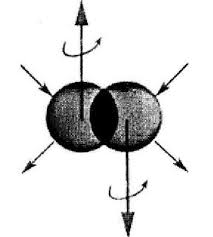New Sciences for a New Era

Some of the most amazing developments in science and technology have been laid down already by some contemporary physicists, and their discoveries and results have been hiding in plain sight for many decades.
In this regard I Invite the curious reader to investigate the body of work of Ruggero Maria Santilli on hadron mechanics.
It is an extremely boring reading for most people (and even for hardcore physicists if you ask me), and yet it opens up many new vistas on the world of physics as well as practical and commercially viable industrial applications like no others we have ever seen.
I shall glide briefly through some of the most notable things and takeaways from Ruggero’s papers:
1) A unified physic which describes seamlessly nature from the macro/relativistic scale all the way down to the micro/quantic world without hitting against singularity type DIV-ZERO situations. Nature has no seams!
2) The recovery of determinism at subatomic/quantic levels which is useful to resolve problems such as: The Schrodinger cat walks in a bar… and he does not.
God plays no dices after all!
3) The complete characterization of anti-matter, anti-gravity along with new cosmological vistas which integrate the same within our current framework of cosmological observations.
No more dark matter or dark energy or neutrinos
4) The practical possibility to extract energy from the aether substrate AKA Free Energy.
5) The reduction of gravity to its basic electromagnetic components with practical aerospace applications AKA Free Gravity and ultimately Free Time (meaning causal time travel by means of crafted gravitational fields).
6) Detailed physical characterization of superconductive materials and material strengths and ways to improve them without the need for trial and error strategies we are currently stuck with.
7) The characterization of the Aether and the hyper mathematics required to quantify and understand it is just in its infancy (Hadron Field Theory), but it points toward an intelligent neural like Universe with an underlying sense of purpose and intelligent behavior.
Now that we have all this nice physic on hand we could think of spending billions of dollars to build super-duper sci-fi machines off all sorts if it wasn’t for the fact that some practical spin off applications of these formulas are already with us and the importance of these is not yet fully recognized nowadays but it will be soon enough.
Among the most notable ones:
1) The synthesis of magnecules (or magnetic molecules) capable of yielding combustion temperatures and efficiencies greater than their normal covalently accepted value. Still no overrunity here but a headache for contemporary chemists to fully understand the technological implications of these new fuels and their industrial applications.
2) The synthesis of neutrons from low pressure hydrogen gas with the flip of a switch.
We are not talking of a billion-dollar machine but a commercial machine connected to a 120 VAC outlet.
Endless applications for nuclear engineering at a fraction of the cost of commercial neutron sources available today and the possibility of building fission type reactors powered by external neutron sources (virtually ZERO fuel cost, simplified “low neutron efficiency” reactor design with inherently safe construction!). Nuclear waste and metallic radiation embrittlement still an issue for long and safe operation of these reactors though.
3) Enhanced decay of nuclear wastes in matter of minutes or hours by means of cyclotron radiation tuned in accordance to hadronic formulas.
4) Nuclear fusion reactors using carbon, oxygen, Nitrogen, etc as nuclear fuel and generating Silicon and other heavy metals as by-products, then the old school fission reactors and the need to deal with nuclear waste will be just a relic of the past.
Again, these are not billion-dollar machines but pressure vessels and electronic operating at industrially available pressures/temperatures.
We furthermore envisage the possibility of industrial synthesis of heavy metals off lighter elements with fusion induced heat as a by product to be disposed of in cooling towers or used for energy production which might well be too cheap to meter compared to the main metallurgical production process.
5) Detection of anti-matter galaxies and other previously unobserved objects by means of concave lenses microscopes along with a type of “cold photon” with negative energy content.
So if you know the formulas with which Nature operates then it is not difficult to build incredible machines, but it does take time to get the attention of the mainstream science and establishment before things start changing for the better.
In fact mainstream academia will not be too happy about all these changes and discoveries as it will steal the attention from multi billion dollar science and physic (yielding little to no industrially meaningful results), and it will bring about a new generation of scientists and physicists with little to no relationship to the old school and teachings, thus causing great embarrassment to the established academia.
The interested reader is welcome to take a look at Ruggero’s body of work and see for himself these formulas and their implications but we have to be pragmatic about them: Often innovation progresses because the old ideas and the professor defending these die and finally the younger and more openminded generations are allowed to experiment and bring about these innovations.
How long will it take for this physic to become mainstream is still to be determined, but it will happen in accordance to perfect timing set forth by historical and karmic forces that have been playing out for many decades for the physical epiphany to occur.

Blogger 1:
The 0.782 MeV missing in the neutron synthesis inside stars originates from the relative kinetic energy of the proton and the electron and not from the Aetrher as claimed by Santilli.
Blogger 1, thanks for bringing to our attention the widespread view on the origin of the missing energy in the neutron synthesis. However, unlike you, Santilli has never made firm claims on said energy and actually has stated various times that said missing energy is the most intriguing ‘open’ problem in physics nowadays, and has then submitted the ‘hypothesis’ of continuous creation of matter in the universe from the aether on grounds of the following ‘three’ experimental data [1]:
1. At 1 MeV the cross section p-e is 10^{-20} barns, namely, it is essentially null, thus precluding any possible interaction, let alone the p-e synthesis no matter what their relative energy is.
2. Medium size stars like our Sun synthesize about 10^{38} neutrons ‘per second. In the event the claim by Blogger 1 is correct, the star would ‘lose’ 10^{38} MeV per second by therefore cooling down and never producing light.
3. According to known astrophysical measurements over centuries, our Sun loses energy into light for about 10^{38} MeV per second which correspond to the (Section 4.3 of [1])
SUN’S LOSS OF MASS PER BLOGGER 1 CLAIM:
10^{23} METRiC TONS PER SECOND
which loss of mass is so huge that our planetary system should have ceased to exist at least 1B years ago.
Our EPR team would greatly appreciate to know whether Blogger 1 remains with his claim or, after inspecting experimental data 1, 2, 3, he/she admits the plausibility of Santilli’s hypothesis or, in its denial, has any alternative equally plausible hypothesis.
On personal grounds, I believe that Santilli’s most important physical discovery has been the existence of an enormous ‘pressure’ on extended particles/wave-packets in the core of a star which is totally absent in QM due to its point-like abstraction of particles, but which is fully treatable via HM in terms of the isotopic element T of the isoproduct A*B = ATB. According to Santilli, under said enormous pressure, a proton in the core of a star has an enormous ‘thermal’ energy, but an essentially null kinetic energy, let alone 0.782 MeV. Regards
[1] R. M. Santilli, “Reduction of Matter in the Universe to Protons and Electrons via the Lie-isotopic Branch of Hadronic Mechanics,”
Progress in Physics, Vol. 19, 73-99 (2023),
https://www.ptep-online.com/2023/PP-65-09.PDF
Looking forward to receive more comments or replies on this
Mrs. Pamela Flapf
Executive Secretary
The EPR Editorial Team
Email admin@eprdebates.org
Website
http://www.eprdebates.org
Blogger 2:
QM is perfectly capable of describing time reversal violating processes, as evident from a proper description of CP violation in the standard model (which also violates time reversal invariance) by introducing a complex phase.